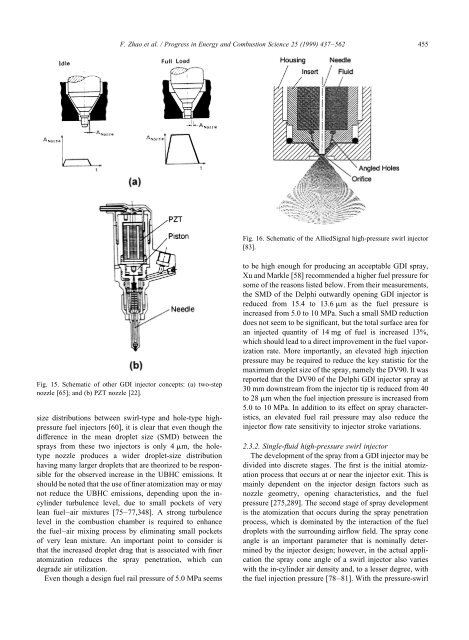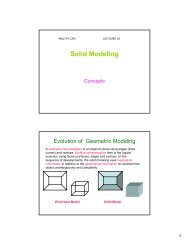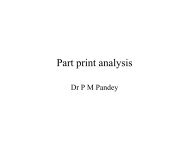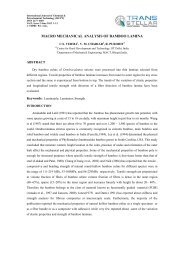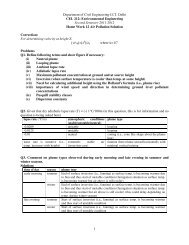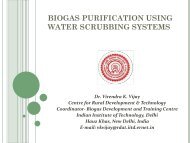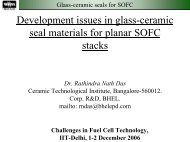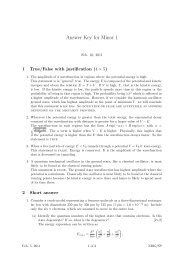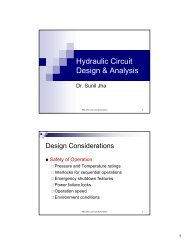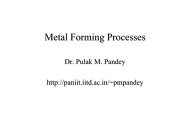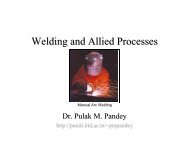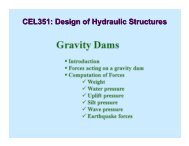Automotive spark-ignited direct-injection gasoline engines
Automotive spark-ignited direct-injection gasoline engines
Automotive spark-ignited direct-injection gasoline engines
You also want an ePaper? Increase the reach of your titles
YUMPU automatically turns print PDFs into web optimized ePapers that Google loves.
F. Zhao et al. / Progress in Energy and Combustion Science 25 (1999) 437–562 455<br />
Fig. 15. Schematic of other GDI injector concepts: (a) two-step<br />
nozzle [65]; and (b) PZT nozzle [22].<br />
size distributions between swirl-type and hole-type highpressure<br />
fuel injectors [60], it is clear that even though the<br />
difference in the mean droplet size (SMD) between the<br />
sprays from these two injectors is only 4 mm, the holetype<br />
nozzle produces a wider droplet-size distribution<br />
having many larger droplets that are theorized to be responsible<br />
for the observed increase in the UBHC emissions. It<br />
should be noted that the use of finer atomization may or may<br />
not reduce the UBHC emissions, depending upon the incylinder<br />
turbulence level, due to small pockets of very<br />
lean fuel–air mixtures [75–77,348]. A strong turbulence<br />
level in the combustion chamber is required to enhance<br />
the fuel–air mixing process by eliminating small pockets<br />
of very lean mixture. An important point to consider is<br />
that the increased droplet drag that is associated with finer<br />
atomization reduces the spray penetration, which can<br />
degrade air utilization.<br />
Even though a design fuel rail pressure of 5.0 MPa seems<br />
Fig. 16. Schematic of the AlliedSignal high-pressure swirl injector<br />
[83].<br />
to be high enough for producing an acceptable GDI spray,<br />
Xu and Markle [58] recommended a higher fuel pressure for<br />
some of the reasons listed below. From their measurements,<br />
the SMD of the Delphi outwardly opening GDI injector is<br />
reduced from 15.4 to 13.6 mm as the fuel pressure is<br />
increased from 5.0 to 10 MPa. Such a small SMD reduction<br />
does not seem to be significant, but the total surface area for<br />
an injected quantity of 14 mg of fuel is increased 13%,<br />
which should lead to a <strong>direct</strong> improvement in the fuel vaporization<br />
rate. More importantly, an elevated high <strong>injection</strong><br />
pressure may be required to reduce the key statistic for the<br />
maximum droplet size of the spray, namely the DV90. It was<br />
reported that the DV90 of the Delphi GDI injector spray at<br />
30 mm downstream from the injector tip is reduced from 40<br />
to 28 mm when the fuel <strong>injection</strong> pressure is increased from<br />
5.0 to 10 MPa. In addition to its effect on spray characteristics,<br />
an elevated fuel rail pressure may also reduce the<br />
injector flow rate sensitivity to injector stroke variations.<br />
2.3.2. Single-fluid high-pressure swirl injector<br />
The development of the spray from a GDI injector may be<br />
divided into discrete stages. The first is the initial atomization<br />
process that occurs at or near the injector exit. This is<br />
mainly dependent on the injector design factors such as<br />
nozzle geometry, opening characteristics, and the fuel<br />
pressure [275,289]. The second stage of spray development<br />
is the atomization that occurs during the spray penetration<br />
process, which is dominated by the interaction of the fuel<br />
droplets with the surrounding airflow field. The spray cone<br />
angle is an important parameter that is nominally determined<br />
by the injector design; however, in the actual application<br />
the spray cone angle of a swirl injector also varies<br />
with the in-cylinder air density and, to a lesser degree, with<br />
the fuel <strong>injection</strong> pressure [78–81]. With the pressure-swirl


